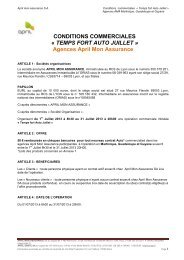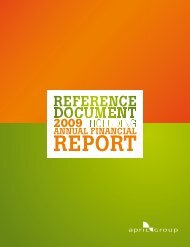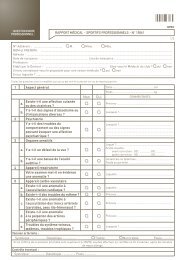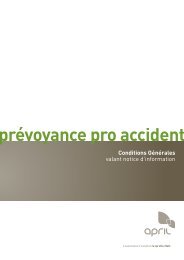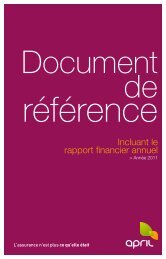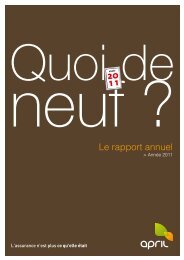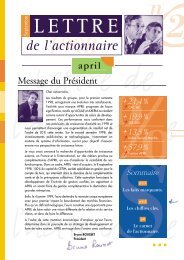2007 - April
2007 - April
2007 - April
Create successful ePaper yourself
Turn your PDF publications into a flip-book with our unique Google optimized e-Paper software.
2.0<br />
Notes to the consolidated financial statements at December 31 st <strong>2007</strong><br />
An impairment in value is recorded when the net book value<br />
of intangible fixed assets and goodwill is higher than their<br />
going value, as determined in this way.<br />
The depreciation recorded for goodwill is non-reversible and<br />
may not be written back if the going value for the goodwill in<br />
question climbs back above its book value.<br />
1.17. Financial investments<br />
Financial investments primarily comprise the investments of<br />
insurance companies included in the basis for consolidation,<br />
notably:<br />
Shares, bonds, equity UCITS or bond UCITS included under<br />
the category of “assets available for sale”. These financial<br />
investments are valued on a fair value basis, with any<br />
unrealized gains or losses booked against shareholders’<br />
equity until their disposal. When sold off, any value<br />
adjustments are recorded on the income statement,<br />
Cash-based UCITS included under the category for<br />
“securities held for transaction purposes”. These assets are<br />
valued on a fair value basis, with any unrealized or realized<br />
gains or losses booked on the income statement.<br />
Stakes in cash-based UCITS recorded under investments for<br />
insurance activities may not exceed 20%, in accordance with<br />
the management constraints put in place by the Group.<br />
No financial assets are included in the category for<br />
investments held through to maturity (HTM).<br />
The fair value corresponds to the market value of financial<br />
instruments at year-end.<br />
The vast majority of financial instruments in the portfolio are<br />
listed on an official, regulated or assimilated market. In such<br />
case, the fair value corresponds to the last known stock price<br />
at year-end or the last net asset value published for UCITS.<br />
In certain rare specific cases or if instruments are not listed,<br />
the fair value may correspond to a valuation by the issuer or<br />
contributors.<br />
Recording in the accounts<br />
The Group records financial assets in its accounts as soon as<br />
it becomes a party to the contract in question. The recording<br />
date corresponds to the date on which transactions are<br />
undertaken. The acquisition costs for financial investments<br />
are directly recorded as expenses over the year since they<br />
do not represent a significant value, either individually or<br />
combined.<br />
Depreciation<br />
Financial assets other than those recorded at fair value<br />
through profit and loss are subject to an impairment test at<br />
each close of accounts.<br />
Assets held for sale are depreciated in the event of any<br />
objective signs of a significant and lasting impairment in<br />
value.<br />
An impairment is recorded for securities with capital losses<br />
for over six months or with capital losses representing over<br />
20% at the close of accounts for shares and UCITS that are<br />
not consolidated, booked as “assets held for sale”.<br />
For debt instruments that are recorded as “assets held for<br />
sale”, APRIL GROUP analyzes the following criteria in order to<br />
identify any objective signs of impairment in value:<br />
Issuers’ financial difficulties or probability of bankruptcy;<br />
Payment defaults on interest or the principal.<br />
The amount of this depreciation charge is equal to the<br />
difference between the book value and the estimated<br />
recoverable value. When this concerns unlisted securities,<br />
in the absence of any market value, the amount of the<br />
depreciation charge is determined in relation to the<br />
security’s value in use. This value in use is determined based<br />
on financial criteria that are adapted to the situation of the<br />
security concerned.<br />
Depreciation charges are recorded on the income statement.<br />
For debt instruments: if the instrument’s fair value increases<br />
subsequently as a result of events occurring after the<br />
impairment, the write-back is booked against earnings. For<br />
equity instruments: any impairments in value recorded on<br />
such instruments are only written back against earnings<br />
when the instrument in question is removed.<br />
1.18. Financial futures and hedging operations<br />
No financial futures or hedging operations are used.<br />
1.19. Receivables from insurance operations or<br />
reinsurance accepted<br />
Receivables from insurance operations comprise premiums<br />
acquired but not issued as well as premiums issued but not<br />
collected, after deducting any premium cancellations.<br />
The amount of premiums acquired but not issued is calculated<br />
at each close of accounts in order to associate the premiums<br />
acquired over the period in question.<br />
103<br />
Return to the contents section




